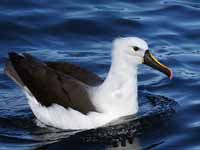BIRDS of THE WORLD - An Online Bird Book
PROCELLARIIFORMES
Albatross
Order Procellariiformes Family Diomedeidae
PROCELLARIIFORMES
Procellariiformes is an order of seabirds that comprises albatrosses, shearwaters, and various type of petrels. Wings are long and narrow; feet are webbed, and the hind toe is undeveloped or non-existent. Plumage is predominantly black, white and gray. They are almost exclusively pelagic (feeding in the open ocean). They distributed across the world's oceans, with the highest diversity being around New Zealand. Procellariiformes mostly nesting on remote predator-free islands. Only a single egg is laid per nesting attempt. The various species within the order have a variety of migration strategies. Many species undertake regular trans-equatorial migrations. However, no albatrosses cross the migrate across the equator because they rely on wind assisted flight.
The order has a few unifying characteristics, starting with their tubular nasal passages enclosed in one or two tubes on their straight, deeply grooved bills with hooked tips. These passages are used for smelling which helps to locate patchily distributed prey at sea and may also help locate their nests within nesting colonies. Also, they have a stomach oil stored that can be used as a food source during their long flights and also as a defense mechanism. All birds have an enlarged nasal gland at the base of the bill, above their eyes. This gland is inactive in species that don't require it; however the Procellariiformes do require its use due to their drinking of ocean water. It removes salt that forms a 5% saline solution that drips out of their nose or is forcibly ejected in some petrels. [abstracted from Wikipedia]
The order has a few unifying characteristics, starting with their tubular nasal passages enclosed in one or two tubes on their straight, deeply grooved bills with hooked tips. These passages are used for smelling which helps to locate patchily distributed prey at sea and may also help locate their nests within nesting colonies. Also, they have a stomach oil stored that can be used as a food source during their long flights and also as a defense mechanism. All birds have an enlarged nasal gland at the base of the bill, above their eyes. This gland is inactive in species that don't require it; however the Procellariiformes do require its use due to their drinking of ocean water. It removes salt that forms a 5% saline solution that drips out of their nose or is forcibly ejected in some petrels. [abstracted from Wikipedia]
Albatross
Order Procellariiformes Family Diomedeidae
Albatrosses are among the largest of flying birds . They range widely in the Southern Ocean and the North Pacific, but are absent from the North Atlantic. They feed on squid, fish and krill by either scavenging, surface seizing or diving. Albatrosses are colonial, nesting for the most part on remote oceanic islands. The nasal tubes of all albatrosses are along the sides of the bill, unlike the rest of the Procellariiformes where the tubes run along the top of the bill. The legs are strong for Procellariiformes, in fact, almost uniquely amongst the order in that they are able to walk well on land. The adult plumage of most of the albatrosses is usually some variation of dark upper-wing and back, white undersides, often compared to that of a gull. Albatrosses take several years to get their full adult breeding plumage.
Albatrosses travel huge distances with two techniques used by many long-winged seabirds, dynamic soaring and slope soaring. Dynamic soaring involves repeatedly rising into wind and descending downwind. Slope soaring uses the rising air on the windward side of large waves. They are aided in soaring by a shoulder-lock, a sheet of tendon that locks the wing when fully extended, allowing the wing to be kept outstretched without any muscle expenditure. Albatrosses in calm seas are forced to rest on the ocean's surface until the wind picks up again. Taking off is one of the few times albatrosses use flapping in order to fly, and is the most energetically demanding part of a journey. When taking off, albatrosses need to run to allow enough air to move under the wing to provide lift.
Genus Diomedea
The "Great" Albatrosses
Albatross,_Northern_Royal Diomedea sanfordi Found: South America, Australasia, Southern (Antarctic) Ocean
The Northen Royal Albatross has dark brown upper-wings; black edges on under-wings; white rest of plumage; pink bill, legs.
Image by: 1) Nuytias Tas - New Zealand 2, 3) Cristian_Pinto 4) Ronald Roan - New Zealand 



Albatross,_Southern_Royal Diomedea epomophora Found: southern oceans including the coasts of South America, Australasia
The Southern Royal Albatross has dark brown upper-wings; black edges on under-wings; black tipped tail; white rest of plumage; pink bill, legs.
Image by: 1) JJ Harrison - Australia 2) Mark Jobling 3, 4) Charlie Westerinen in the Drake's Passage 5) Claudio Timm 6) Alexandre_Roux - New Zealand 7) David Cook7) Southern Royal Albatroos on left; Black-browed Albatross on right







Albatross,_Wandering Diomedea exulans Found: Africa, Australasia, The Southern Ocean
The largest albatross. The plumage varies with age, with the juveniles starting chocolate brown. Adults have white bodies with black and white wings.
Image by: 1) Dimitri off the west coast of KerguelenDamasceno 2) Charlie Westerinen - off Wollongong, Australia 3) Mark Jobling 4) JJ_Harrison - Tasmania
5) Charlie - the Drake's Passage 6) David Cook - Continental shelf, off Eden, NSW, Australia 7) Claudio_Timm 






Genus Phoebastria
North Pacific Albatross
Albatross,_Black-footed Phoebastria nigripes Found: Northern Pacific including North America, Asia
The Black-footed Albatross has mainly black plumage; white forehead, around base of bill; black bill, feet.
Image by: 1) Seabamirum 2) Greg Schechter - California 3) Jason Crotty - California 4) Forest & Kim Starr - Midway Atoll 5) Jame Lloyd 6) Tony_Morris





Albatross,_Laysan Phoebastria immutabilis Found: Northern Pacific including North America, Asia
The Laysan Albatross has blackish-gray upperparts except for white head, tail; white underparts; black and whiate under-wing; pink bill with dark tip.
Image by: 1, 2, 3, 4, 5, 6, 7, 8) Dick Daniels - Kilauea Lighthouse on Kauai, Hawaii and also at Princeville, Kauai,







Albatross,_Short-tailed Phoebastria albatrus Found: Northern Pacific including North America, Asia
The Short-tailed Albatross has mainly white upperparts with black and white wings; yellow-stained nape, crown; pink bill with blue tip on older birds.
Image by: 1) Andy Colins, USFWS - Midway Atoll 2) C. Fred Ziellerman, USFWS 3) James Lloyd - Midway Atoll 4) Noah Kahn, USFWS - Midway Atoll 5, 6) Tony_Morris1) Adult and young 2) Juvenile






Albatross,_Waved Phoebastria irrorata Found: Galapagos Islands, Columbia, Ecuador, Peru
The Waved Albatross has mainly brownish bodies; yellowish-cream nap; mainly white, head, upper-breast; long bright yellow bill; blue feet.
Image by: 1) David Cook - Galapagos 2) D. Gordon Robertson - Galapagos Islands 3) Harvey
Barrison - Galapagos 4) Amy McAndrews - off Peru.



Genus Phoebetria
The closest relatives of these albatross are in genus Thalassarche, the mollymarks.
Albatross,_Light-mantled Phoebetria palpebrata Found: the Southern (Antarctic) Ocean, Africa, Argentina, Australia, New Zealand
The Light-mantled Albatross has mainly sooty-brown or blackish upperparts; darker head; whitish mantle; pale underparts.
Image by: 1) David Cook - South Georgia (Southern Ocean) 2) Tom Tarrant - Australiat 3) Natalie Tapson 4) Soerfm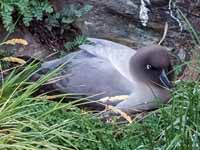



Albatross,_Sooty Phoebetria fusca Found: Africa, Antartic island, South America, Australia
The Sooty Albatross has sooty-brown plumage; lighter on underparts; darker shading on sides of head.
Image by: 1) JJ Harrison 2) Pinned 3) Charlie Westerinen on the Drake Passage1) Juvenile



Genus Thalassarche
The albatrosses in this genus are medium sized and are also called Mollymarks.
Albatross,_Black-browed Thalassarche melanophris Found: South America, Asia, Africa, Australasia, Antarctic
The Black-browed Albatross has white neck, head; dark gray rest of underparts; white underparts; dark under-wing; dark eyebrow; yellow-orange bill; darker tip.
Image by: 1, 2) Nick Athanas - Falkland Islands 3, 4) David Cook - Australia 5, 6) Charlie Westerinen 7) Ed_Dunens, Australia 8) David Cook6) Southern Royal Albatroos on left; Black-browed Albatross on right

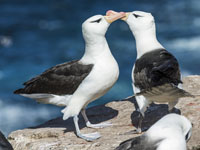




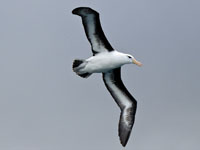

Albatross,_Buller's Thalassarche bulleri Found: Australasia
The Butler's Albatross has dark gray back, upper-wing; tail; white rest of plumage.
Image by: 1) Dominique Filippi - Snares
Island, New Zealand 2, 6) David Cook 3) Sabine's
Sunbird2)
4) JJ_Harrison 5) Duncan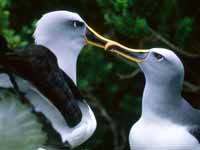





Albatross,_Chatham Thalassarche eremita Found: west coast South America, Australasia; breed Chatham Islands of New Zealand
The Chatham Albatross has gray upperparts; white rump, underparts; black edge to under-wing; yellow bill with dark spot on tip.
Image by: 1) Craig Nash 2) Dan Mantle 3) Cristian_Pinto 4) Anita_Gould 5) Owheelj 




Albatross,_Gray-headed Thalassarche chrysostoma Found: south Africa, Australasia, Chile
Image by: 1) Ben Tullis 2) JJ_Harrison 3. 4) David Cook 5) Charlie Westerinen in the Drakes Passage
1) Chick





Albatross,_Salvin's Thalassarche salvini Found: Southern Oceans including around New Zealand
The Salvin's Albatross has silver-gray crown; gray upper mantle, upper-throat; gray-black back, upper-wing; white neck, underparts; pale gray-green bill with pale yellow ridge and bright yellow tip.
Image by: 1) Arthur Chapman 2) JJ Harrison 3) Andrej_Chudy 4) Mjobling



Albatross,_Shy also White-capped Albatross Thalassarche cauta Found: Africa, Australasia
The Shy Albatross has gray-black mantle, upper-wing, tail; white head, neck, underparts; under-wings have black edge; gray-yellow bill with yellow tip.
Image by: 1) JJ Harrison - Tasmania, Australia 2, 4) Ed_Dunens - Victoria 3, 5) Charlie Westerinen - east of Wollongong, Australia




Albatross,_Yellow-nosed Thalassarche chlororhynchos Found: southern Atlantic and Pacific Oceans , Africa
The Yellow-nosed Albatross is often split into two species: the Atlantic Yellow-nosed
Albatross (Thalassarche chlororhynchos) and the Indian Yellow-nosed Albatross (Thalassarche
carteri)..
Image by: 1, 2) David Cook - Continental shelf, off Eden, NSW, Australia 3) Charlie Westerinen - of Wollongong, Australia
